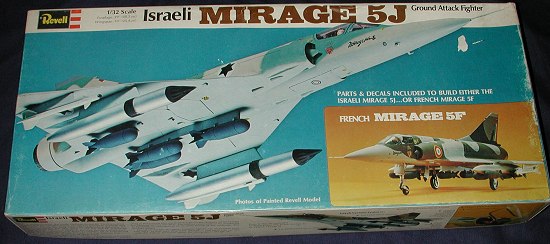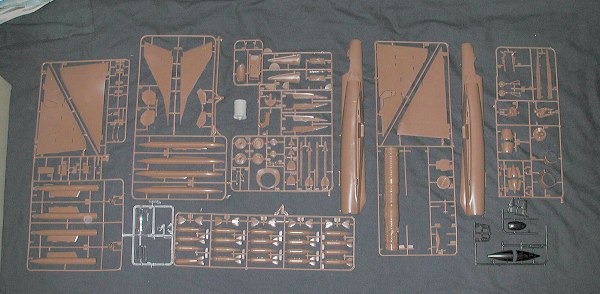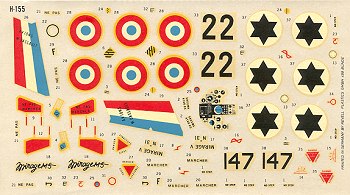
|
KIT: |
Revell 1/32 Mirage 5 |
|
KIT # |
H-155 |
|
PRICE: |
Who knows. Kit is long OOP |
|
DECALS: |
Two aircraft |
|
REVIEWER: |
|
|
NOTES: |
Instructions dated 1975 |

|
HISTORY |
At the beginning, the Mirage 5 was conceived to answer Israeli requirements, but after the Six Days War on June 5, 1967, General de Gaulle decreed the embargo on the order of 50 aircraft, which thereafter were repurchased by France and modified to the Mirage 5 F.
Having produced "up-market" and "down-market" Mirages, Dassault took care to make aircraft of intermediate quality. Adjusting electronic equipment composition, Dassault was able to satisfy all the requests of potential Mirage 5 customers. This process went so far that engineers virtually re-invented the Mirage III. The most striking example is the Mirage 5 EAD, for Abu Dhabi ; these aircraft are equipped with a Cyrano radar placed in the nose, and a navigation Doppler under the fuselage, exactly like those of the Mirage IIIE. The Mirage 5 BA of the Force Aérienne Belge, although deprived of radar, are also equipped with rather advanced navigation and attack systems.
Mirage 5, like Mirage III family planes, came out from the Mérignac
factory. The production ended in 1985 and totaled some 532 aircraft, some
of them produced under license in Belgium. The aircraft had a great
export success: Abu Dhabi, Belgium, Colombia, Egypt, Gabon, Libya,
Pakistan, Peru, Venezuela and Zaire among those who purchased the types.
In June 1982, 10 Mirage 5 P were sold to Argentina by Peru to make up for
losses in the Falkands War. In 1970 and 1972, Israel launched the
manufacture of a practically identical aircraft named Nesher.
Initially not envisaged for France, the Mirage 5 F equipped the
Escadron de Chasse 3/13 Auvergne, based in Colmar and the Escadron de
Chasse 3/3 Ardennes, in Nancy-Ochey. This last unit was transitioned to
the Jaguar and its aircraft were taken over by Escadron 2/13 Alpes, in
Colmar. The last Mirage 5 F flew on June 29, 1999 thus marking the end of
many years of service within the Armée de l'Air.
Thanks to Conservatoire de l'Air et de l'Espace d'Aquitaine (CAEA) for the historical background.
|
THE KIT |

Well, I know darn little about this kit other than I couldn't pass it up at a recent swap meet. I like big airplane kits; it is just that I don't build enough of them due to lack of display space for them, among other reasons. This one is done in a brown plastic though there are also black and light grey bits. Being a swap meet kit, the engine halves have already been glued together. Kit detailing is a mixture of raised and engraved panel lines. The main panels are engraved with the smaller ones raised.
There are the usual problems with some sink areas next to alignment pins and ejector pin marks on landing gear and other similar parts. Nothing unusual for kits of this era. A bit of flash here and there as well; again, nothing unusual. The level of detail isn't as high as one would expect from a modern kit. The detail is a touch 'soft' compared to what we now expect. There are quite a few options on this one. For one thing, it has a pilot figure. The cockpit is really well done with a seat, cockpit tub and control stick. Instrument panel is a decal and considering the age of the decals, this may pose a problem.
The kit has a full engine so you'll need quite a bit of nose weight to keep this one from tail-sitting. Main wheels and nose gear are designed to roll and the canopy has a small hinge so you can display it open or closed. Weapons load consists of rocket pods or fuel tanks with bomb attachment points. A separate set of bombs are supplied for the centerline and a ventral racks. Two Sidewinders are also provided, but I would imagine that the French 5F would have Matra Magics. There are separate elevon actuator housings if the Sidewinders are not being used.
 Instructions are quite good
and typical of the age. Colors given are generic in nature and color info
provided throughout the construction process. Decals are provided for two
planes, both shown on the box top. One is an Israeli version in a
desert scheme and the other a French aircraft in the European scheme.
Frankly, I think that both sets of markings are probably spurious once one
gets past the insignia and data decals. The sheet is fairly well printed,
though I think the blue is too light. However, it is quite old and
yellowed. I'm not sure how well it would react to water after all these
years. I'm sure there are aftermarket decals around for this kit somewhere
as they will be needed, I do believe.
Instructions are quite good
and typical of the age. Colors given are generic in nature and color info
provided throughout the construction process. Decals are provided for two
planes, both shown on the box top. One is an Israeli version in a
desert scheme and the other a French aircraft in the European scheme.
Frankly, I think that both sets of markings are probably spurious once one
gets past the insignia and data decals. The sheet is fairly well printed,
though I think the blue is too light. However, it is quite old and
yellowed. I'm not sure how well it would react to water after all these
years. I'm sure there are aftermarket decals around for this kit somewhere
as they will be needed, I do believe.
|
CONCLUSIONS |
Once again, a case of the only game in town when it comes to injected plastic 1/32 Mirages. It may not be the most accurate, but should provide a good basis for those who don't mind putting a bit of extra effort into a model. Finding decals may be a problem, but even right out of the box, it shouldn't be that difficult a build.
If you would like your product reviewed fairly and fairly quickly by a site that has over 200,000 visitors a month, please contact me or see other details in the Note to Contributors.